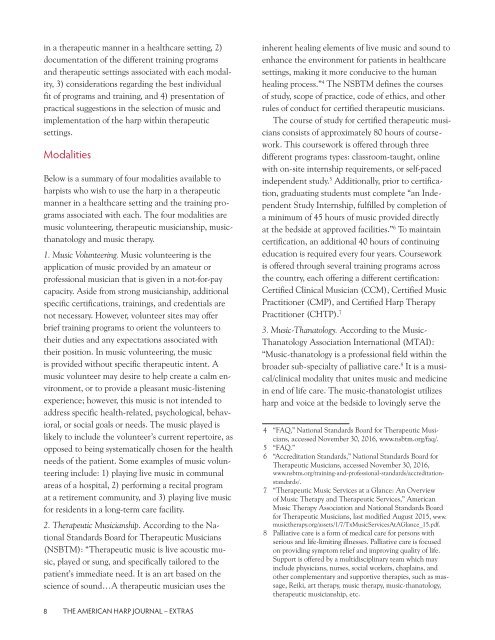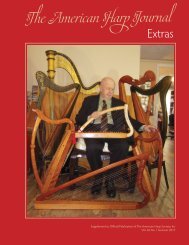The American Harp Journal - Extras - Summer 2018
Supplement to Vol. 26 No. 3 (Summer 2018) of The American Harp Journal
Supplement to Vol. 26 No. 3 (Summer 2018) of The American Harp Journal
You also want an ePaper? Increase the reach of your titles
YUMPU automatically turns print PDFs into web optimized ePapers that Google loves.
in a therapeutic manner in a healthcare setting, 2)<br />
documentation of the different training programs<br />
and therapeutic settings associated with each modality,<br />
3) considerations regarding the best individual<br />
fit of programs and training, and 4) presentation of<br />
practical suggestions in the selection of music and<br />
implementation of the harp within therapeutic<br />
settings.<br />
Modalities<br />
Below is a summary of four modalities available to<br />
harpists who wish to use the harp in a therapeutic<br />
manner in a healthcare setting and the training programs<br />
associated with each. <strong>The</strong> four modalities are<br />
music volunteering, therapeutic musicianship, musicthanatology<br />
and music therapy.<br />
1. Music Volunteering. Music volunteering is the<br />
application of music provided by an amateur or<br />
professional musician that is given in a not-for-pay<br />
capacity. Aside from strong musicianship, additional<br />
specific certifications, trainings, and credentials are<br />
not necessary. However, volunteer sites may offer<br />
brief training programs to orient the volunteers to<br />
their duties and any expectations associated with<br />
their position. In music volunteering, the music<br />
is provided without specific therapeutic intent. A<br />
music volunteer may desire to help create a calm environment,<br />
or to provide a pleasant music-listening<br />
experience; however, this music is not intended to<br />
address specific health-related, psychological, behavioral,<br />
or social goals or needs. <strong>The</strong> music played is<br />
likely to include the volunteer’s current repertoire, as<br />
opposed to being systematically chosen for the health<br />
needs of the patient. Some examples of music volunteering<br />
include: 1) playing live music in communal<br />
areas of a hospital, 2) performing a recital program<br />
at a retirement community, and 3) playing live music<br />
for residents in a long-term care facility.<br />
2. <strong>The</strong>rapeutic Musicianship. According to the National<br />
Standards Board for <strong>The</strong>rapeutic Musicians<br />
(NSBTM): “<strong>The</strong>rapeutic music is live acoustic music,<br />
played or sung, and specifically tailored to the<br />
patient’s immediate need. It is an art based on the<br />
science of sound…A therapeutic musician uses the<br />
inherent healing elements of live music and sound to<br />
enhance the environment for patients in healthcare<br />
settings, making it more conducive to the human<br />
healing process.” 4 <strong>The</strong> NSBTM defines the courses<br />
of study, scope of practice, code of ethics, and other<br />
rules of conduct for certified therapeutic musicians.<br />
<strong>The</strong> course of study for certified therapeutic musicians<br />
consists of approximately 80 hours of coursework.<br />
This coursework is offered through three<br />
different programs types: classroom-taught, online<br />
with on-site internship requirements, or self-paced<br />
independent study. 5 Additionally, prior to certification,<br />
graduating students must complete “an Independent<br />
Study Internship, fulfilled by completion of<br />
a minimum of 45 hours of music provided directly<br />
at the bedside at approved facilities.” 6 To maintain<br />
certification, an additional 40 hours of continuing<br />
education is required every four years. Coursework<br />
is offered through several training programs across<br />
the country, each offering a different certification:<br />
Certified Clinical Musician (CCM), Certified Music<br />
Practitioner (CMP), and Certified <strong>Harp</strong> <strong>The</strong>rapy<br />
Practitioner (CHTP). 7<br />
3. Music-Thanatology. According to the Music-<br />
Thanatology Association International (MTAI):<br />
“Music-thanatology is a professional field within the<br />
broader sub-specialty of palliative care. 8 It is a musical/clinical<br />
modality that unites music and medicine<br />
in end of life care. <strong>The</strong> music-thanatologist utilizes<br />
harp and voice at the bedside to lovingly serve the<br />
4 “FAQ,” National Standards Board for <strong>The</strong>rapeutic Musicians,<br />
accessed November 30, 2016, www.nsbtm.org/faq/.<br />
5 “FAQ.”<br />
6 “Accreditation Standards,” National Standards Board for<br />
<strong>The</strong>rapeutic Musicians, accessed November 30, 2016,<br />
www.nsbtm.org/training-and-professional-standards/accreditationstandards/.<br />
7 “<strong>The</strong>rapeutic Music Services at a Glance: An Overview<br />
of Music <strong>The</strong>rapy and <strong>The</strong>rapeutic Services,” <strong>American</strong><br />
Music <strong>The</strong>rapy Association and National Standards Board<br />
for <strong>The</strong>rapeutic Musicians, last modified August 2015, www.<br />
musictherapy.org/assets/1/7/TxMusicServicesAtAGlance_15.pdf.<br />
8 Palliative care is a form of medical care for persons with<br />
serious and life-limiting illnesses. Palliative care is focused<br />
on providing symptom relief and improving quality of life.<br />
Support is offered by a multidisciplinary team which may<br />
include physicians, nurses, social workers, chaplains, and<br />
other complementary and supportive therapies, such as massage,<br />
Reiki, art therapy, music therapy, music-thanatology,<br />
therapeutic musicianship, etc.<br />
8 THE AMERICAN HARP JOURNAL – EXTRAS




